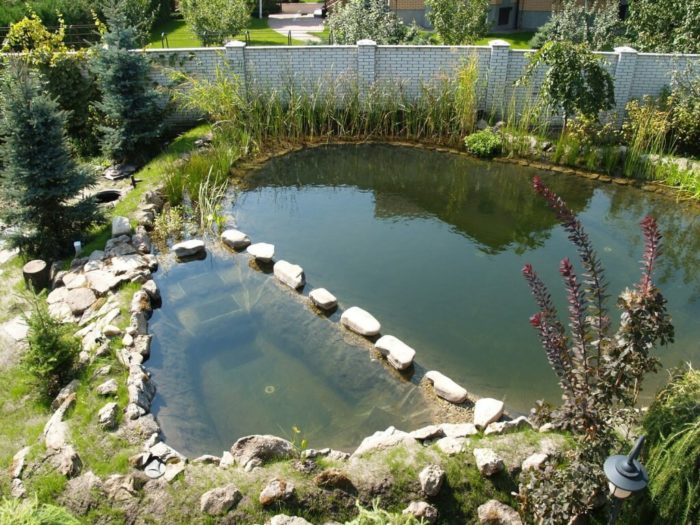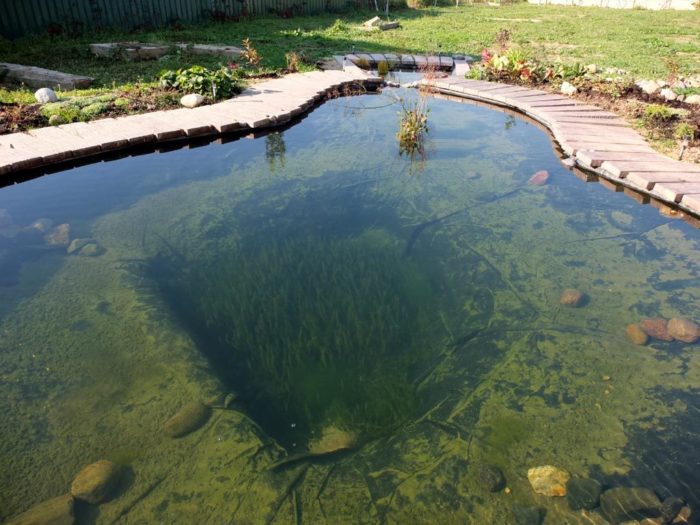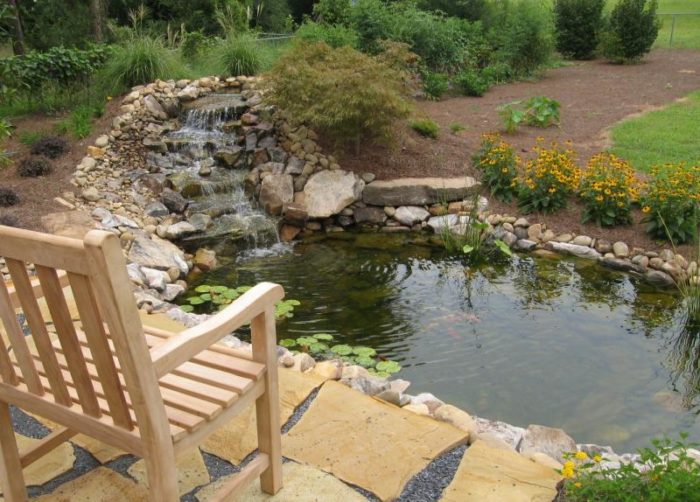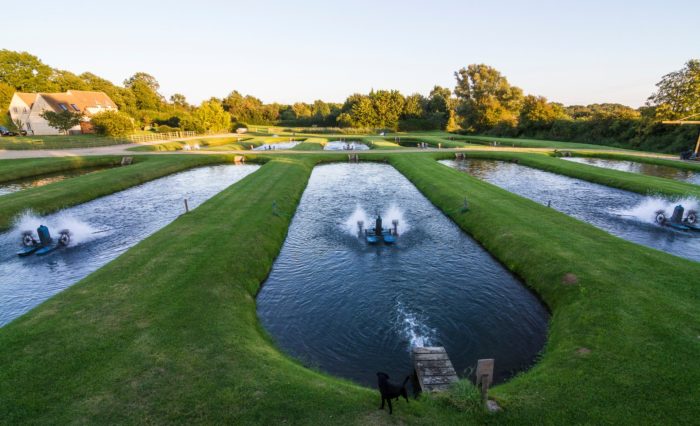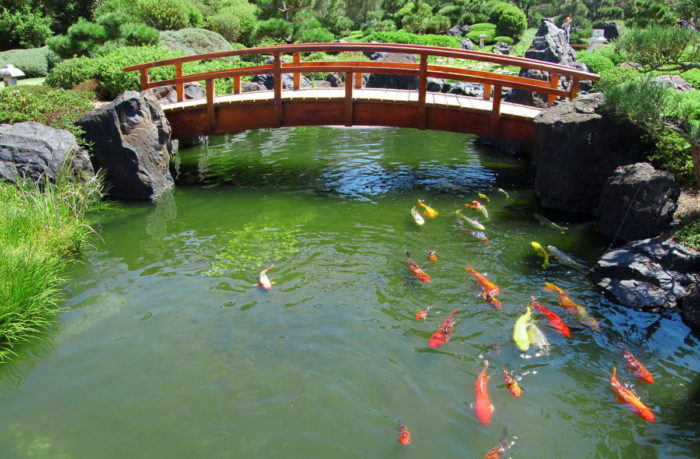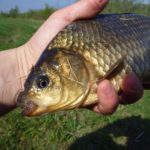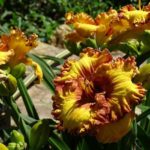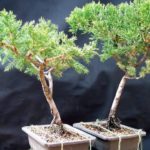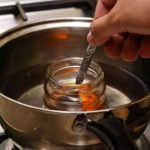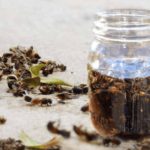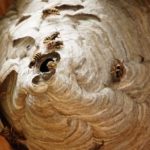Creating a pond for artificially breeding fish has a number of features. You can implement this idea for your own pleasure or use it to implement a profitable business project. It is important to study all the nuances. This will give you the opportunity to get a good result. Today, there are several options for arranging such ponds - with or without concreting, using plastic or film.
What types of ponds are there?
Before setting up a fish pond at your dacha, it is recommended to decide on its type.Such reservoirs are classified according to the following criteria:
- The purpose of the pond is that it can be used for spawning, wintering, feeding, and growing.
- Water supply - reservoirs can be spring, stream or dug.
- Bottom material - there are natural and artificial varieties.
Ponds are also divided into types according to manufacturing technologies:
- Concrete - considered practical and durable. At the same time, creating such a reservoir is a very labor-intensive process.
- Without concreting - in this case, the boundaries of the pit must be lined with turf and clay.
- With PVC film - considered a simple solution, but has a limited service life.
- Plastic - limited in size. This solution should be used for growing small and ornamental fish.
Which area is suitable for a pond?
To make a pond with your own hands, you need to choose the right site. It is important that this location meets a number of requirements. These include the following:
- Elevation – it is important that the pond is located in a high place. Thanks to this, wastewater will not enter the reservoir, causing its pollution. If the pond is planned to be concreted, groundwater will not destroy it. You can create a hill artificially. To do this, it is recommended to take soil from the pit.
- Lighting - it is important that the pond is illuminated for 5-6 hours in the morning. In this case, it is permissible to organize barriers on the southern and western sides artificially. In the complete absence of light, plants will not develop in the pond. This will negatively affect the growth of the fish.
- Soil - the optimal solution is a clay sole, which holds water well. In other cases, the pit must be dug in such a way that the future walls do not crumble.
- Trees – there should be no trees or bushes near the pond. Otherwise, fallen leaves and other debris will fall into the pond. This factor can be ignored if it is possible to systematically clean the pond.
- Size of the plot - in this case, you should focus on the purpose of the pond. If you plan to breed fish for sale, a small plot of land will not be suitable.
It is important to consider that the well, sewage system and other structures must be placed as far as possible from the reservoir. The optimal size of a future pond for growing fish is 30-60 square meters. If ideal natural conditions are created, you can build a larger pond. In this case, the form does not matter much. In this matter, you can focus on your capabilities and comfort.
Creation methods
It is quite possible to create a pond on your site with your own hands. In this case, it is important to choose the right arrangement option.
Without concrete
This type should be used when the ground is waterlogged and the groundwater is high. To dig an artificial pond and equip it, you should prepare the following:
- turf;
- shovel;
- clay;
- water;
- outlet pipes;
- putty knife.
First you need to mark the boundaries and dig a pit of suitable depth. It is permissible to create a pond in the area of a natural ravine on the site. At the same time, it should be expanded and deepened, creating an earthen dam. It should be poured along the entire length in layers measuring 15-20 centimeters, compacting well. It is important that the dam is located 50 centimeters above the water level in the pond. Its end should be surrounded by a ditch. It will help drain the flood.
After preparing the hole, it is recommended to do the following:
- Make holes for the tubes and install them.
- Cover the walls and bottom of the pond with diluted clay.In this case, the thickness of such a layer should be 10-15 centimeters. After which the walls need to be evenly treated with turf. It is also permissible to mix clay with turf in equal parts and dilute the composition with water. The mass should be so thick that it does not spread. It needs to evenly cover the bottom and walls of the pit.
- Fill the pond with water. However, it is prohibited to introduce fish there at this stage. It is important that the pond stands for at least 1 month. Thanks to this, the bottom will be covered with silt and it will be possible to plant plants. In such conditions they will successfully take root.
- After a month, drain the water and refill the reservoir. Once suitable conditions have been created, fish can be released.
If supply and bypass ditches are made, it is recommended to provide gutters made of concrete. In the case of using a natural ravine on the crest of the dam, it is worth making a shoreline. To do this, it is recommended to pour a layer of sand measuring 10-15 centimeters. In this case, the width of the coastline should be 1 meter.
With film
Making a pond this way is quite simple. This method is considered the most flexible and does not require compliance with special construction requirements. To implement this idea, it is recommended to prepare the following materials:
- digging tools;
- drainage pipes;
- black film - its thickness should be 0.5-1 millimeter;
- stones or pegs.
This method makes it possible to obtain boundaries of any irregular shape. The film will be placed around the perimeter and, when the recess is filled with water, will take on the desired shape. To arrange a pond in this way, it is recommended to do the following:
- Outline the boundaries of the future reservoir.
- Dig a hole.
- Make channels for drainage.
- Line the recess with film and make holes where the pipes join.
- Secure the edges of the film. This can be done with stones or pegs.
The optimal solution for insulating a pond is polyethylene. If the pond is large, it is recommended to use a custom-made film that has high strength parameters.
Polyethylene waterproofing has the following advantages:
- affordable price;
- ease of installation;
- the pond is ready for use immediately after installation;
- durability of the material;
- ease of repair;
- safe for fish and algae.
With concreting
The advantage of this option for an artificial pond on a summer cottage is the significant period of operation. However, its implementation will require a lot of effort and time. To set up such a pond, it is recommended to prepare the following:
- crushed stone;
- sand;
- shovel;
- reinforcing mesh;
- cement;
- water;
- putty knife;
- tubes;
- film.
It is recommended to make the concreting composition yourself. Supply from a machine is suitable for arranging reservoirs of large areas, since there will be a lot of concrete.
To create a pond using this method, it is recommended to do the following:
- Mark the boundaries. In this case, you can choose any shape for the future reservoir, but it is important to take into account the features of the upcoming work. You should not make sharp bends, as they will be very difficult to complete.
- Dig a pit. At this stage, it is recommended to take into account that the concrete layer takes up some space, which will reduce the capacity of the reservoir. Compliance with the angle of inclination of the side surfaces is of no small importance. Its size should be 20 degrees.
- Get rid of debris and tree roots.
- Make holes so that the reservoir can be filled with water and drained. They require tubes to be installed.
- Compact the soil.This can be done with your feet, but it is much more effective to use a special device.
- To build a pond in soft soil, pour a thin layer of crushed stone. Then you should arrange a sand cushion 1 centimeter thick. It is necessary to begin compacting the soil only after such preparation.
- Construct waterproofing. To do this, it is recommended to take the film, lay it on the bottom and press it against the walls. Use stones or pegs to secure the edges at the top.
- Prepare the concrete composition. For 1 part of cement, it is recommended to take 3 times more filler - sand and crushed stone. When adding water, it is important to ensure that the mass is thick enough.
- Lay out the first layer of concrete and wait until it hardens completely. It is recommended to repeat this procedure several times. As a result, you need to get a layer of concrete 10 centimeters thick.
- Without waiting for the concrete to dry, apply reinforcing mesh to the walls. It needs to be applied to the desired area and pressed down a little. This stage is considered optional, but it makes it possible to obtain a strong support.
- Apply another layer of concrete to the reinforcement. Its thickness should be 5 centimeters.
- Smooth out uneven surfaces with a spatula.
- Wait for the composition to dry. In sunny and dry weather, it is recommended to cover the concrete with moistened burlap or grass. In hot weather, it is worth spraying the coating with ordinary water. This will help prevent cracks from forming in the material.
Plastic
When constructing a plastic pond on a site, the main difficulties arise at the stage of adjusting the shape of the pit to the relief of the plastic. Such frames are usually made to order.Therefore, it is important to think in advance what you want your pond to look like and get expert advice.
The tools required are not much different from constructing a structure using other methods. The main device is a plastic frame. It is necessary to adjust the remaining parameters when constructing a pond.
To build a structure, it is recommended to do the following:
- Measure the frame.
- Make markings on the ground taking into account the size and shape of the plastic frame.
- Dig a hole.
- Make an allowance around the perimeter of 6-7 centimeters to be able to make adjustments.
- Place the mold and run channels to accommodate the water supply pipes.
- Connect the pipes and level the space around the perimeter of the structure.
How to prepare a pond for settlement
After constructing a pond, it is important to fill it with water and leave it for at least a month. Thanks to this, an optimal environment will be created in the reservoir. After this, the water must be drained and refilled. Only after this can the reservoir be populated. In addition to settling, at the preparatory stage it is recommended to plant vegetation and install certain equipment. It includes the following:
- filter – used to cleanse the reservoir of contaminants;
- aerator – ensures saturation of water with oxygen;
- heater - required in winter;
- skimmer – helps purify water and make it clear;
- silt sucker - used to clean the bottom of the pond;
- UV sterilizer – helps prevent blooming and clouding.
It is recommended to choose the type of equipment taking into account the size of the pond and its population. In this case, a large number of situations are possible. Therefore, before purchasing this or that equipment, it is recommended to obtain specialist advice.
Before constructing and populating a pond, it is recommended to determine the type of its inhabitants. This affects the arrangement of the reservoir, its size and the equipment that is planned to be used. The following fish can be stocked in a decorative pond:
- Koi carps prefer deep bodies of water. They have average winter tolerance and are considered very voracious. Therefore, vegetation should be abundant.
- Goldfish need plenty of space. They have a hard time surviving the winter. Therefore, the reservoir needs to be equipped with heaters.
- Minnows are considered schooling fish that are undemanding to conditions. At the same time, they need a lot of oxygen.
When building a pond for edible fish, you should give preference to the following varieties:
- Perch and crucian carp are undemanding in terms of living conditions and food.
- Carp cannot withstand cold water temperatures less than +10 degrees.
- Tench is considered an undemanding fish, but requires significant space.
The construction of an artificial pond on a summer cottage has certain features. It is important to determine its purpose. The arrangement of the reservoir will depend on this.

